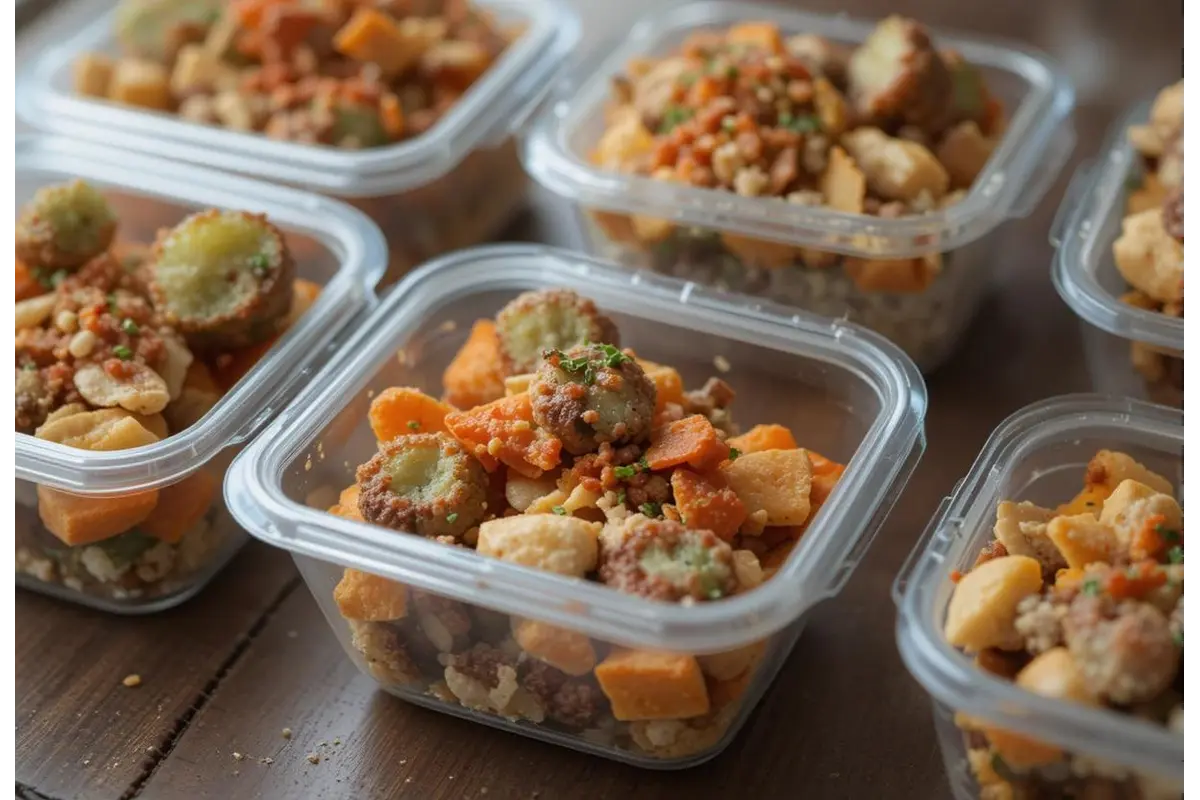Meal prep has become a cornerstone of maintaining a healthy lifestyle in today’s busy world. At the heart of this trend is the humble yet essential meal prep container. These containers not only keep your food fresh and organized but also contribute to portion control, reduce waste, and save time. Whether you are a busy professional, a parent managing meals for your family, or someone trying to stick to a healthier eating plan, meal prep containers are the tools you didn’t know you needed.
But selecting the right meal prep containers can feel overwhelming with so many options on the market. Should you choose glass, plastic, or stainless steel? Do you need single-compartment containers, or should you invest in multi-compartment designs? This comprehensive guide answers all these questions and more, giving you everything you need to start or refine your meal prep journey.
Table of Contents
Why Meal Prep Containers Are Essential
It’s worth asking: why are meal prep containers so important? The answer lies in their versatility and the numerous benefits they offer. Beyond just storing food, they have evolved into indispensable tools for improving efficiency in the kitchen, reducing waste, and fostering healthier eating habits.
1. Time-Saving Convenience
First and foremost, meal prep containers are excellent for saving time. Instead of cooking meals daily, you can batch-cook your meals for the entire week and store them in ready-to-go portions. For instance, imagine having a fridge stocked with pre-portioned lunches and dinners. This eliminates the guesswork about what to eat, saving precious minutes every day.
Consider this: how many times have you hesitated over what to cook for dinner, only to settle for unhealthy takeout? With meal prep containers, that stress vanishes, leaving you more time to focus on other priorities.
Real-Life Example
Busy parents juggling work and children’s schedules often find meal prep to be a lifesaver. By prepping meals over the weekend, they ensure their family has access to healthy, home-cooked meals throughout the week. For instance, preparing four trays of lasagna or roasted chicken thighs with vegetables and dividing them into containers ensures meals are ready to heat and eat when life gets hectic.
2. Reducing Food Waste
Additionally, meal prep containers reduce food waste. How often do leftovers get forgotten in the back of the fridge, only to be thrown away days later? By portioning meals and storing them properly, you ensure that every bite is eaten and nothing goes to waste. Plus, fewer trips to the grocery store mean less impulsive buying, which often leads to overstocking perishable items.
Reducing Household Waste
Meal prep containers also help you creatively repurpose leftovers. For example:
- Roast a large batch of chicken on Sunday and use the shredded leftovers for tacos, salads, or stir-fries throughout the week.
- Turn leftover rice into fried rice, rice bowls, or even rice pudding, storing them in individual portions.
3. Promoting Healthier Eating Habits
Meal prep containers encourage healthier eating. When your meals are prepped in advance, it’s easier to stick to balanced, nutritious options rather than reaching for unhealthy snacks or fast food. For example, using containers to store perfectly portioned meals helps you control calorie intake and maintain a balanced diet effortlessly.
If you need more meal ideas, check out these mediterranean food recipes or winter soup recipes that pair well with meal prep containers. These recipes can inspire your weekly planning and add variety to your routine.
Portion Control for Weight Management
Pre-portioning is particularly beneficial for those following specific diets, such as keto, vegan, or high-protein plans. With containers, you can ensure your meals align with your goals, reducing the temptation to stray.
4. Supporting Sustainability
Finally, we can’t ignore the environmental benefits of using reusable meal prep containers. According to the EPA, opting for reusable containers reduces reliance on single-use plastics, helping to minimize your environmental footprint. If you’re transitioning to a more eco-conscious lifestyle, meal prep containers are a simple but impactful step in the right direction.
Sustainable Choices
When selecting containers, look for durable materials like glass or stainless steel, as they last longer and reduce the need for replacements. Many brands also offer eco-friendly packaging or recycled materials, adding to their appeal.
Types of Meal Prep Containers
To find the best meal prep containers for your needs, it’s important to understand the different types available. Each type has distinct advantages, so choosing the right one depends on your lifestyle, preferences, and cooking habits.
1. Material-Based Containers
One of the first decisions to make is which material to choose. Common materials include glass, plastic, and stainless steel, each with unique features.
Glass Containers
Glass containers are highly durable, eco-friendly, and ideal for reheating meals in the microwave. However, they are heavier than other options, which may make them less convenient for on-the-go meals. These containers are excellent for home use and oven-safe recipes.
Advantages:
- Non-porous, so they don’t retain odors or stains.
- Microwave and oven safe (without lids).
- Transparent, allowing you to easily see the contents.
Disadvantages:
- Fragile and can break if dropped.
- Heavier than other options.
Plastic Containers
Lightweight and affordable, plastic containers are a popular choice. Make sure to choose BPA-free plastic for safety. However, they may stain over time, especially when storing tomato-based dishes or curries. Despite this drawback, their affordability makes them a practical option for families.
Advantages:
- Lightweight and portable.
- Affordable and available in a wide variety of sizes.
Disadvantages:
- Prone to staining and retaining odors.
- Less durable over time compared to glass or stainless steel.
Stainless Steel Containers
These containers are sleek, durable, and perfect for those avoiding microwaves. While they are less versatile than glass or plastic, they are long-lasting and stylish. Stainless steel is also ideal for those focused on eco-friendliness and avoiding food-related chemical exposure.
Advantages:
- Extremely durable and resistant to wear.
- Eco-friendly and recyclable.
Disadvantages:
- Not microwave safe.
- Higher upfront cost.
2. Compartment-Based Containers
Another key feature to consider is the container’s design. Compartment-based options are especially useful for balanced meals.
Single-Compartment
Best for meals that don’t require separation, such as pasta dishes, soups, or salads. They’re also ideal for storing bulk-prepared ingredients like rice or roasted vegetables.
Multi-Compartment
These containers keep different food items separate, making them ideal for meals with proteins, carbs, and vegetables. If you enjoy variety in your meals, these are a must-have for ensuring your sides stay distinct from your mains.
Key Features to Look for in Meal Prep Containers
To make an informed decision, pay close attention to the following features:
1. Size and Capacity
Select sizes that match your portioning needs. For instance, families may require larger containers, while single individuals can opt for smaller ones. Having a mix of sizes ensures flexibility for various types of meals, from large casseroles to individual snack packs.
2. Durability
Choose materials that can withstand daily use. Glass is particularly durable, while high-quality BPA-free plastic can also last for years. For those who often take meals to work or school, consider containers with reinforced lids to prevent breakage.
Benefits of Using Meal Prep Containers
1. Health Benefits
Portion control is one of the greatest advantages of meal prep containers. By pre-measuring servings, you can maintain a balanced diet effortlessly. For example, multi-compartment containers make it easy to include a mix of protein, carbs, and vegetables in every meal.
2. Economic Savings
Prepping meals at home saves money. Instead of spending on takeout or ready-made meals, you can cook in bulk and store your food for the week. A one-time investment in quality containers pays for itself by reducing food expenses over time.
3. Convenience
Imagine coming home from work and having a fully prepared meal waiting in the fridge. This convenience makes sticking to a meal plan much easier. Meal prep containers simplify your evenings, freeing up time for relaxation or hobbies.
4. Environmental Benefits
Reusable containers reduce plastic waste. By choosing glass or stainless steel, you’re contributing to a greener planet. The shift away from single-use plastics also sets a positive example for others, encouraging eco-conscious habits.
Easy Meal Prep Recipe: Chicken, Veggie, and Rice Bowls
Now that you understand the importance of meal prep containers, let’s dive into a simple and delicious recipe that can easily be paired with this cloud bread.
Ingredients (Makes 4 Servings)
- 2 large chicken breasts (boneless, skinless)
- 2 cups cooked brown rice
- 2 cups steamed broccoli
- 1 cup diced bell peppers
- 1 tablespoon olive oil
- 1 teaspoon garlic powder
- 1 teaspoon paprika
- Salt and pepper to taste
Instructions
- Prepare the Chicken: Preheat your oven to 375°F (190°C). Season the chicken breasts with olive oil, garlic powder, paprika, salt, and pepper. Bake for 20-25 minutes or until fully cooked. Slice into strips once cooled.
- Cook the Rice: Prepare the brown rice according to package instructions.
- Steam the Vegetables: Steam the broccoli and dice the bell peppers.
- Assemble the Bowls: Divide the rice, chicken, broccoli, and bell peppers evenly into meal prep containers. Seal tightly.
- Store and Reheat: Refrigerate for up to four days. Reheat in the microwave for 2-3 minutes before eating.
Pro Tips for Effective Meal Prep
To maximize the benefits of meal prep containers, follow these tips:
- Plan Meals in Advance: Create a weekly menu and stick to it. Having a clear plan ensures variety and reduces last-minute stress.
- Label Containers: Write down the contents and dates to avoid confusion. Labeling helps you track expiration dates and reduces waste.
- Store Properly: Use the right container for the right type of food. For instance, glass is ideal for acidic foods, while plastic works well for dry ingredients.
- Clean Immediately: Prevent stains and odors by washing containers promptly. If you use plastic containers, avoid storing foods like curry or tomato sauce for extended periods.
Conclusion
Start small, experiment with different container types, and enjoy the journey toward a more efficient and sustainable kitchen. By taking control of your meals and storage, you can create a system that benefits both your health and the planet. There is always room for desserts, and you can finish on a sweet note with this brookie recipe or these delicious cake pops.
Meal prep containers are more than just kitchen tools—they are a gateway to a healthier, more organized lifestyle. Whether you’re looking to save time, cut costs, or eat healthier, investing in quality containers is a smart move. With the tips, insights, and recipe provided in this guide, you’re well on your way to mastering meal prep.

